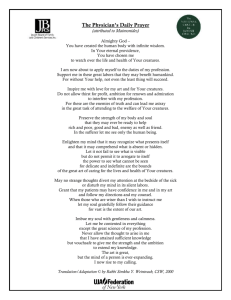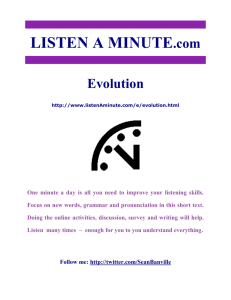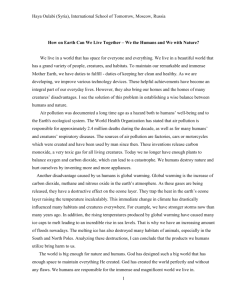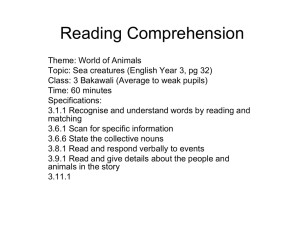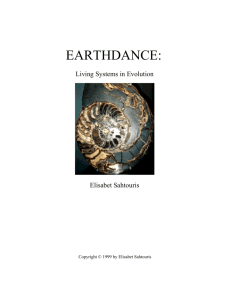A Change of Heart About Animals
advertisement
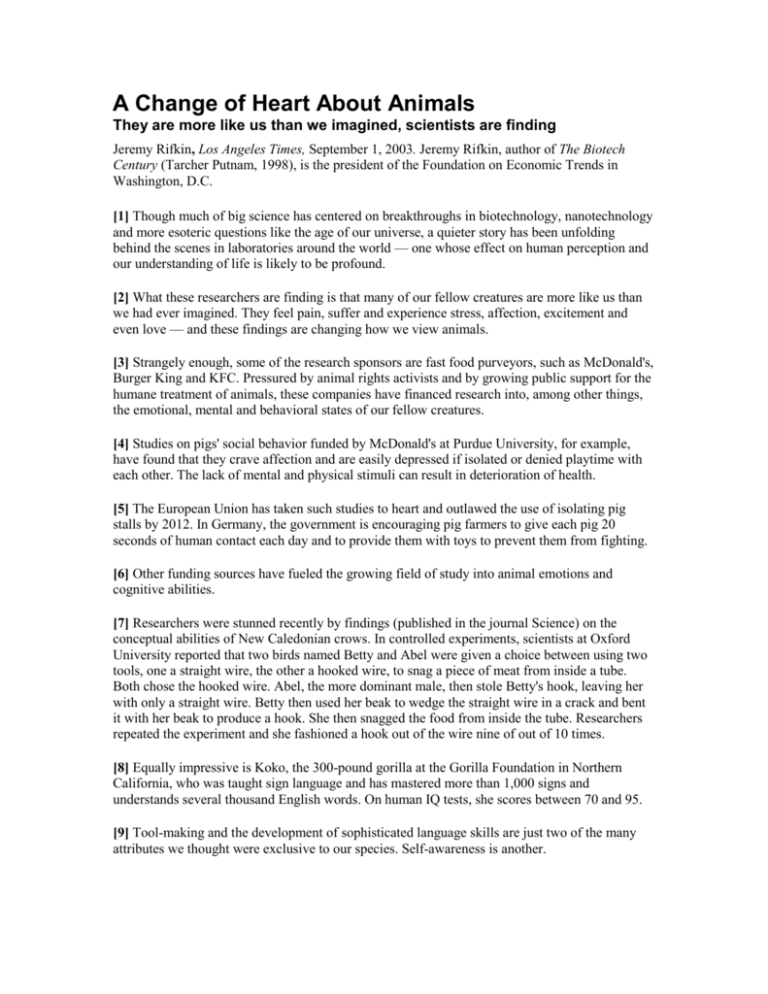
A Change of Heart About Animals They are more like us than we imagined, scientists are finding Jeremy Rifkin, Los Angeles Times, September 1, 2003. Jeremy Rifkin, author of The Biotech Century (Tarcher Putnam, 1998), is the president of the Foundation on Economic Trends in Washington, D.C. [1] Though much of big science has centered on breakthroughs in biotechnology, nanotechnology and more esoteric questions like the age of our universe, a quieter story has been unfolding behind the scenes in laboratories around the world — one whose effect on human perception and our understanding of life is likely to be profound. [2] What these researchers are finding is that many of our fellow creatures are more like us than we had ever imagined. They feel pain, suffer and experience stress, affection, excitement and even love — and these findings are changing how we view animals. [3] Strangely enough, some of the research sponsors are fast food purveyors, such as McDonald's, Burger King and KFC. Pressured by animal rights activists and by growing public support for the humane treatment of animals, these companies have financed research into, among other things, the emotional, mental and behavioral states of our fellow creatures. [4] Studies on pigs' social behavior funded by McDonald's at Purdue University, for example, have found that they crave affection and are easily depressed if isolated or denied playtime with each other. The lack of mental and physical stimuli can result in deterioration of health. [5] The European Union has taken such studies to heart and outlawed the use of isolating pig stalls by 2012. In Germany, the government is encouraging pig farmers to give each pig 20 seconds of human contact each day and to provide them with toys to prevent them from fighting. [6] Other funding sources have fueled the growing field of study into animal emotions and cognitive abilities. [7] Researchers were stunned recently by findings (published in the journal Science) on the conceptual abilities of New Caledonian crows. In controlled experiments, scientists at Oxford University reported that two birds named Betty and Abel were given a choice between using two tools, one a straight wire, the other a hooked wire, to snag a piece of meat from inside a tube. Both chose the hooked wire. Abel, the more dominant male, then stole Betty's hook, leaving her with only a straight wire. Betty then used her beak to wedge the straight wire in a crack and bent it with her beak to produce a hook. She then snagged the food from inside the tube. Researchers repeated the experiment and she fashioned a hook out of the wire nine of out of 10 times. [8] Equally impressive is Koko, the 300-pound gorilla at the Gorilla Foundation in Northern California, who was taught sign language and has mastered more than 1,000 signs and understands several thousand English words. On human IQ tests, she scores between 70 and 95. [9] Tool-making and the development of sophisticated language skills are just two of the many attributes we thought were exclusive to our species. Self-awareness is another. [10] Some philosophers and animal behaviorists have long argued that other animals are not capable of self-awareness because they lack a sense of individualism. Not so, according to new studies. At the Washington National Zoo, orangutans given mirrors explore parts of their bodies they can't otherwise see, showing a sense of self. An orangutan named Chantek who lives at the Atlanta Zoo used a mirror to groom his teeth and adjust his sunglasses. [11] Of course, when it comes to the ultimate test of what distinguishes humans from the other creatures, scientists have long believed that mourning for the dead represents the real divide. It's commonly believed that other animals have no sense of their mortality and are unable to comprehend the concept of their own death. Not necessarily so. Animals, it appears, experience grief. Elephants will often stand next to their dead kin for days, occasionally touching their bodies with their trunks. [12] We also know that animals play, especially when young. Recent studies in the brain chemistry of rats show that when they play, their brains release large amounts of dopamine, a neurochemical associated with pleasure and excitement in human beings. [13] Noting the striking similarities in brain anatomy and chemistry of humans and other animals, Stephen M. Siviy, a behavioral scientist at Gettysburg College in Pennsylvania, asks a question increasingly on the minds of other researchers. "If you believe in evolution by natural selection, how can you believe that feelings suddenly appeared, out of the blue, with human beings?" [14] Until very recently, scientists were still advancing the idea that most creatures behaved by sheer instinct and that what appeared to be learned behavior was merely genetically wired activity. Now we know that geese have to teach their goslings their migration routes. In fact, we are finding that learning is passed on from parent to offspring far more often than not and that most animals engage in all kinds of learned experience brought on by continued experimentation. [15] So what does all of this portend for the way we treat our fellow creatures? And for the thousands of animals subjected each year to painful laboratory experiments? Or the millions of domestic animals raised under the most inhumane conditions and destined for slaughter and human consumption? Should we discourage the sale and purchase of fur coats? What about fox hunting in the English countryside, bull fighting in Spain? Should wild lions be caged in zoos? [16] Such questions are being raised. Harvard and 25 other U.S. law schools have introduced law courses on animal rights, and an increasing number of animal rights lawsuits are being filed. Germany recently became the first nation to guarantee animal rights in its constitution. [17] The human journey is, at its core, about the extension of empathy to broader and more inclusive domains. At first, the empathy extended only to kin and tribe. Eventually it was extended to people of like-minded values. In the 19th century, the first animal humane societies were established. The current studies open up a new phase, allowing us to expand and deepen our empathy to include the broader community of creatures with whom we share the Earth.

